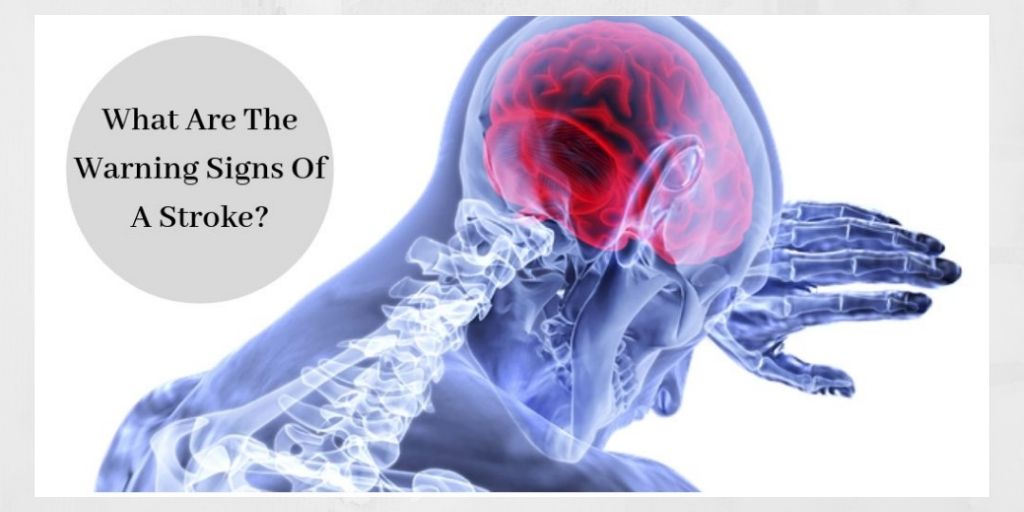Strokes can be devastating. They’re one of the top five causes of death in the United States and the number one cause of long-term disability. What are the warning signs of a stroke? Familiarizing yourself with these signs could save your life or that of a loved one. FAST is an acronym that makes it easy to remember these warning signals. Call help immediately if any are apparent.

This is not the time to hold onto your dignity for fear of looking paranoid. Better safe than sorry. The stakes are just too high. And don’t go to great lengths to not burden those around you. They’ll be far more burdened if you do have a stroke and they end as your caretaker. Every second counts when someone is having a stroke!
Table of Contents
What Happens During A Stroke?
A stroke occurs when blood flow to the brain is cut off. Whereas, a heart attack affects the heart, a stroke is a “brain attack.” During a stroke, blood flow to the brain is cut off. This is caused by a ruptured blood vessel or a blood clot, also called a thrombus. The aftermath of the stroke will depend on which area of the brain was affected, and how much damaged occurred.
It is possible to recover completely from a stroke or suffer only minor complications, like temporary weakness. Devastating strokes, however, can leave a person permanently paralyzed on one side of their body. Strokes may also affect memory, vision, and speech. Up to 2/3rds of stroke victims will incur some type of disability.
A procedure called mechanical thrombectomy is successful in some people if it is performed within six to 24 hours from symptom onset. Medications that dissolve clots must be administered within 3-4 hours to be effective.
Two Types Of Strokes
Hemorrhagic and ischemic are the two types of strokes. The former is caused by a ruptured blood vessel, causing bleeding in the brain. Aneurysms can cause blood vessels to rupture, and are caused by chronically elevated blood pressure. Some aneurysms are congenital. Fortunately, hemorrhagic strokes are not nearly as common as ischemic strokes as they are often fatal.
An ischemic stroke, the most common type, is caused by a blockage, usually a clot, in a blood vessel that carries blood to the brain. Women are unique when it comes to strokes, and may not exhibit the same symptoms as men. Some of these signs are often not attributed to a stroke, delaying treatment. They include: nausea, vomiting, difficulty breathing, fainting, pain, weakness, loss of consciousness, hiccups, drowsiness, and even seizures.
Click here for direct-to-consumer lab testing – Cardio Genomic Plus Profile
Alterations in mental status are also cause for concern, and may include: Confusion, disorientation, sudden changes in behavior, agitation, unresponsiveness, and hallucinations. Interestingly, a higher percentage of women experience altered mental status than do men. Strokes kill more women than men – even though men are more likely to experience a stroke. This could be due to the fact that women live longer, and experience more stress. Pregnancy and use of birth control are other risk factors.
What Are The Warning Signs Of A Stroke?
Time is of the utmost importance if any of these warning signs are apparent. Immediately call 911 if you suspect you or anyone near you is exhibiting signs of a stroke. Don’t wait longer than a few minutes.
And be aware that you don’t need to be experiencing every symptom. Err on the side of caution if you think there’s even a slight possibility of stroke risk.
The treatment window is very narrow for stroke victims so immediate treatment is paramount to increase the chances of survival and recovery. 1.9 million neurons are lost every minute a stroke is not treated.
Medication And Clotting
Studies by The American Stroke Association show that stroke sufferers who take medication to break up clots within three hours of symptom onset decrease their chances of long-term disability when experiencing an ischemic stroke. This type of stroke is by far the most common, and accounts for up to 85 percent of all strokes.
- Numbness or weakness on one side of the body. This could include the face, an arm, or a leg. A smile that is uneven or drooping is cause for concern. Ask the person to raise their arms if you are in doubt. If the arm drops or is unsteady consider that a warning sign.
- Confusion that comes on suddenly is another sign, as is difficulty talking and understanding what is being said. Ask the person to repeat a word. If their speech is slurred, they are in danger.
- Issues with balance and coordination are also signs, as is dizziness.
- Difficulty walking
- A severe headache that comes on suddenly.
- Vision that is blurry in one or both eyes
- The “T” in FAST stands for TIME which is critical in the case of stroke. Symptoms of a stroke come on quickly and without warning.
Check out this book: “Prevent Cancer, Strokes, Heart Attacks & Other Deadly Killers: How to Prevent and Reverse the Hidden Cause of Our Most Devastating Diseases”
Risk Factors For A Stroke
- High blood pressure
- Atrial fibrillation (AFib)
- Diabetes and problems with circulation
- Lack of physical activity
- Alcohol consumption
- Smoking
- Obesity
- Improper eating habits
[Read More: High Intensity Interval Training Workouts [Lose Weight & Keep It Off]
Transient Ischemic Stroke Symptoms
TIAs are mini strokes that do not result in any long-term damage, and are caused by decreased blood flow to the brain or spinal cord. The symptoms are temporary, but a TIA may be a harbinger of a more serious stroke on the horizon. This short-lived neurological dysfunction usually resolves within a 24-hour period.
Symptoms may include weakness, numbness, paralysis on one side of the body, slurred speech, vision difficulties, and confusion. There may, however be no symptoms. Risk factors include insulin resistance, nutrient deficiencies, particularly magnesium, potassium and vitamin C, high blood pressure, and smoking.
[Read More: What Is The Insulin Index? [A Tool For Permanent Weight Loss]
Key Points
Every four minutes someone dies from a stroke, and up to 80 percent of occurrences are preventable. Those are sobering statistics.
Strokes can be life altering and devastating. Be aware of the risk factors, and learn to recognize the signs of a stroke. It really is a matter of life and death.
Have you or someone you know had a stroke? Let me know in the comments:)
References:
(1) NCBI: Ischemic Stroke
(2) NCBI: Acute Stroke (Cerebrovascular Accident)
(3) US National Library of Medicine / National Institutes of Health: Diagnosis and management of acute ischemic stroke: speed is critical
(4) US National Library of Medicine / National Institutes of Health: Diagnosis and management of acute ischemic stroke: speed is critical
(5) NCBI: Comparison of neurological clinical manifestation in patients with hemorrhagic and ischemic stroke
(6) Science Daily: Stroke News
(7) Mayo Clinic: STROKE AND VASCULAR DISEASE: OWEN A. ROSS
Disclaimer: This article is strictly for informational purposes only and is not intended to be medical advice. Please be diligent and always do your own research in regard to any material I present on this site. I claim no responsibility for any distress, whether it be physical or emotional, that may occur as a result of the information you obtain from my blog.




Thank you so much for writing this article. I have heard of the FAST acronym before, but it was also great to see you go over some of the signs that are not covered by the acronym. I feel much more equipped to recognize a possible stroke and to know what to do, God forbid, in the event one happens.
You are doing an important work here in informing others about the dangers, signs, and ways of preventing strokes. Thanks again!
Thank you. The FAST acronym is an easy way to remember and recognize the warning signs of a stroke. It’s important that everyone familiarize themselves with these signs as it could save their own life or someone they love. I appreciate you taking the time to comment!
Hi!
I’m glad that I found your post. I think it is very interesting and very necessary that people know and be able to detect the warning signs of a stroke. Some people don’t even know what a stroke is, so I think that makes it even more difficult for them to react when and if someone does have a stroke.
I hope many people learn about this thanks to your post and when more people know about this, I hope the statistics change and less people die.
Best,
Mariana
Thank you. I’m glad you found my post too. It’s essential that people know how to recognize if they themselves or someone around them is having a stroke. The consequences are too dire not to be educated about it.
You’re right, many people, although they’ve heard of strokes, don’t know what they are or the warning signs. I hope as more and more people get educated, that less people die each year of a devastating stroke!